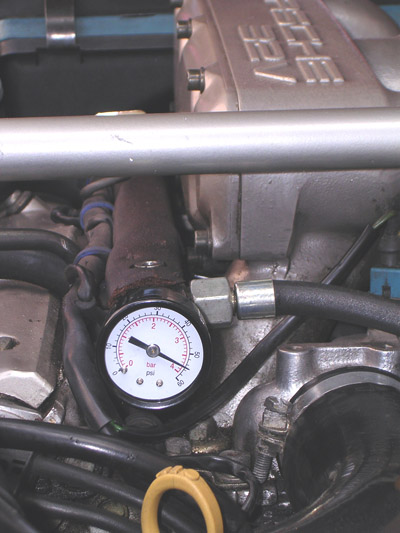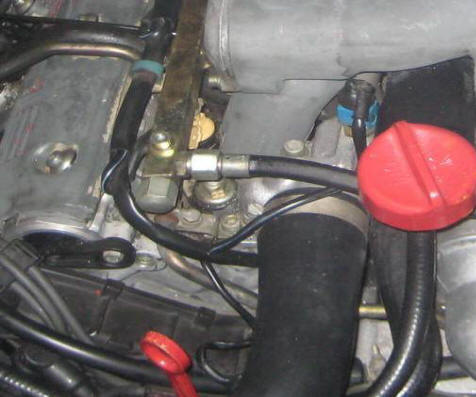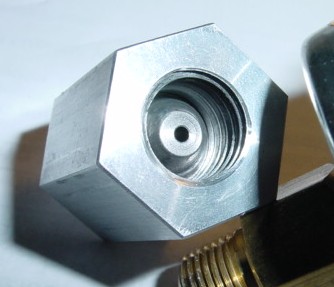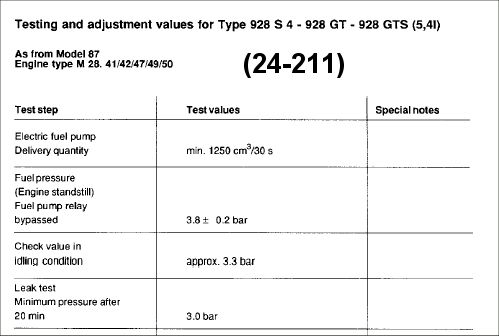





Fuel Pressure
Tony,
The amount of fuel you talk about may seem high but you should remember
that only a portion of the fuel flowing is burnt as the rest is recycled
into the tank. This is all to do with fluid dynamics and the ability to
control the system. By flowing a greater amount of fuel than is needed it
is possible to keep stable [constant] pressure in the headers. The amount
of fuel passed per unit time depends upon the orifice diameter [i.e. the
diameter of the injector needle and the differential pressure. With a
constant pressure in the fuel rail, it is thus possible to precisely inject
the required amount of fuel as the computer determines how long the
injector should remain open.
The computer can thus shut off fuel flow during no load conditions [i.e
during braking or overrun] and thus improve economy.
Dave Roberts at 928 Specialists advertises a kit for monitoring fuel
pressure [about $30]. I use a somewhat hairier homebrew but it works.
Measuring the fuel pressure, and more importantly, measuring the system's
ability to hold pressure, tell you a lot about the state of health of your
fuel system.
You can carry out the fuel delivery test if you really want to but I am not
so sure it will tell you an awful lot. If the fuel pump packs up you will
know about it. If you do carry it out, you can use a length of hose
secured
to the discharge port of the pressure controller [I did it using a clear
PVC hose] but understand that if the connection fails you are going to get
fuel all over the place.
When carrying out any tests of this kind I recommend having a friend
standing by with a hose running water just in case!
Note: the pressure figure you quoted is for a "shut-in" head test [i.e
no
flow]. For a test under running conditions the pressure is less, 3.3 bar
+/- 0.2 bar [multiply bar by 14.5 to get PSIG]. This is the test you should
look for in the first instance and will be simple with the DR kit.
Regards
Fred R
Oman
1990 S4 auto
==========================================
Ok...since i have this sharks belly all open I'm going to test its
"blood flow" aka. fuel pressure and rate.
Any tips or pointers?
I see the book specs for fuel delivery are a min of 1250 cc/30 sec.
Now please excuse my perhaps lack of intelligence but doesn't 1250cc correspond
to 1.25 liters ?? A simple hose into a 2 liter soda bottle should work
huh?
The reason i ask is that this seems like a lot of gas in 30sec? doesn't it?
Am i right or way off the mark.
Fuel pressure of 3.8 bar +- .2 bar. (still trying to find a pressure tester..
any good brands?)
Any gotchas in any of these procedures? (besides not lighting a match : ))
Ready to pass gas
Tony
===========================================
Hi Steve,
How is beautiful Cape Town these days?
1. Your problem could be the check valve, [especially if you do not have
one fitted for some weird reason]. On later models like mine the check
valve screws into the pump body on the discharge side. You may easily
confuse it for a fitting to mount the petrol line but you should see the
hexagons for removing it.
2. The units you refer to are the pressure regulator [back of the fuel rail
on cylinder 1 side], and the fuel pressure dampers [one front, one rear of
fuel rail]. After time the diaphragms go and start to leak fuel into the
vac hoses. Pull the vac hose off and stick the pad of your finger onto the
top of the unit. If your finger smells of petrol the unit is shot. Take a
tip, if one has gone the others are about to so replace the lot at one hit
[unless your records indicate recent partial replacement].
3. You could have a leaky injector but it does not sound like that.
My fuel pressure is about 55 psig but we may have different specs.
I replaced the lot on mine recently.
Good luck
Fred R
Oman
1990 S4 auto
====================
John,
Since no-one has answered you yet, I'll risk it. The 'Bosch Fuel Injection
and Engine Management' book states that the system pressure for pulsed
injection systems (such as yours) is typically 2.5 bar (36 psi). In the
section 'Residual Pressure Test', it states that the pressure in the system
should not have fallen below 1 bar (14.5 psi) 20 minutes after the engine
has been shut off.
My wild-a**ed guess is that the system is not intended to maintain pressure
for four weeks.
Glenn Evans
====================
At 02:50 AM 5/5/01, Dan Dragner wrote:
>Help! I have a " lean misfire " . I've spent the
better part of 6 months trying to figure out this one. What fuel pressure should I have, using stock injectors and regulator on a '86. My Porsche Technical manual
says 29 psi. Seems low to me. I have read other owners running about 58 psi.
From the shop manual:
Fuel pressure with relay jumpered, engine off - 2.3 - 2.7 bar (33.3
-
39.2 psig).
Wally Plumley
===========
pump bridged engine not running 2.5 bar + - .2 bar , at idle approx 2 bar at the fuel rail . pressure at the pump should be similar since the regulators on the rail maintain the pressure bypassing / returning the excess fuel and pressure to the tank . BAR equals 14.5 lbs
Jim Bailey
928 International
Jim@928intl.com
=====
Just curious,
What should the fuel pressure be on a 1990 GT? I've read in some threads that it
should be 48, and others that it should be 60psi?
I have a rich running, and rough idle issue I am troubleshooting. The pressure
gauge in the fuel rail is reading 60psi at idle. Is this too high? Could this be
causing my issue?
If it is, how can I troubleshoot the problem?
Thanks,
- Matt
====
60psi is too high, 3,8bar +/- 0,2 at standstill, 3,3bar idling for the s4,gt,gts
I think that engine standstill means, engine not running (which is why they are
asking us to bypass the fuel pump relay).
===
Verify that you actually have vacuum at the line to the FPR. In many cases, the
vacuum hoses and plumbing get disconnected, or they leak/break/etc due to age.
In any of those cases, there will be little or no vacuum applied to the
regulator. When the fuel press regulator sees no vacuum, it interprets that as
starting or full-load conditions and raises the fuel pressure to help. At idle
of course, the car will have higher vacuum under normal circumstances so the
pressure will be lower.
A Mity-Vac tool is becoming an essential diagnostic tool for 928 owners, along
with a vacuum gauge and an assortment of connecting hose sizes. Use it to verify
that the regulator itself is able to hold vacuum. Some cases have seen a leaking
diaphragm, allowing fuel to be drawn into the intake via the vacuum tubing and
hoses. The leakage and the lack of vacuum holding the diaphragm will give you a
rich mixture, and will make hot restarts a tedious process as you 'unflood' it.
Standstill? Engine off, no vacuum applied to the FPR, and why I suggested that
you find out if you do have vacuum on it when the engine is idling. Makes the
rest of the diagnosis a bit easier I think.
__________________
Bob Fuelleman
===========

========
A pre-1980 has different specs: pressure is 5.2 - 5.8 bar with a fuel delivery of 1120cc in 30 seconds (free flow) for a single pump, 1360cc in 30 seconds for the dual pump setup.